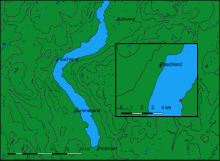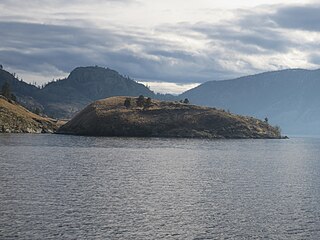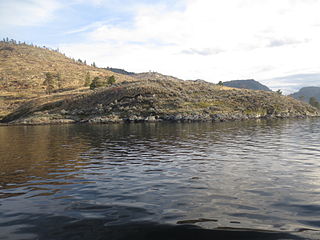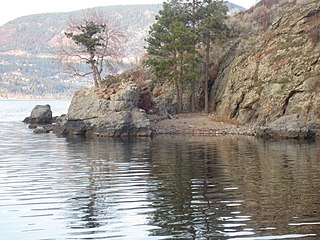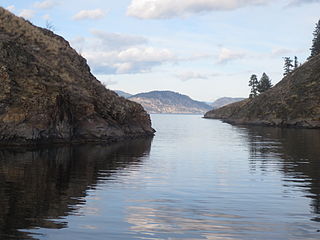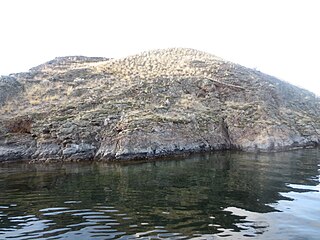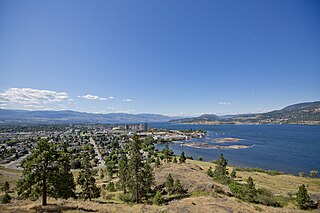
Kelowna is a city on Okanagan Lake in the Okanagan Valley in the southern interior of British Columbia, Canada. It serves as the head office of the Regional District of Central Okanagan. The name Kelowna derives from the Okanagan word kiʔláwnaʔ, referring to a grizzly bear.

In Canadian folklore, the Ogopogo is a lake monster said to inhabit Okanagan Lake in British Columbia, Canada. Some scholars have charted the entity's development from First Nations folklore and widespread water monster folklore motifs. The Ogopogo now plays a role in the commercial symbolism and media representation of the region.
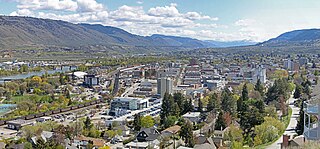
Kamloops is a city in south-central British Columbia, Canada, at the confluence of the North and South Thompson Rivers, which join to become the Thompson River in Kamloops, and east of Kamloops Lake. It is located in the Thompson-Nicola Regional District, whose district offices are based here. The surrounding region is sometimes referred to as the Thompson Country.
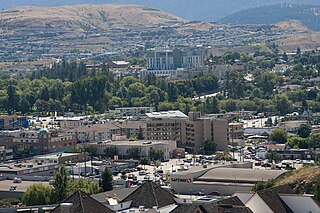
Vernon is a city in the Okanagan region of the Southern Interior of British Columbia, Canada. It is 440 km (270 mi) northeast of Vancouver. Named after Forbes George Vernon, a former MLA of British Columbia who helped establish the Coldstream Ranch in nearby Coldstream, the City of Vernon was incorporated on 30 December 1892. The City of Vernon has a population of 40,000 (2013), while its metropolitan region, Greater Vernon, had a population of 58,584 as of the 2011 Canadian census. With this population, Vernon is the largest city in the North Okanagan Regional District. A resident of Vernon is called a "Vernonite".

Okanagan Lake is a lake in the Okanagan Valley of British Columbia, Canada. The lake is 135 km (84 mi) long, between 4 and 5 km wide, and has a surface area of 348 km2.

Osoyoos is the southernmost town in the Okanagan Valley in British Columbia between Penticton and Omak. The town is 3.6 km (2.2 mi) north of the United States border in the Washington State and is adjacent to the Osoyoos Indian reserve. The origin of the name Osoyoos was the word sw̓iw̓s meaning "narrowing of the waters" in the local Okanagan language (Syilx'tsn). The "O-" prefix is not indigenous in origin and was attached by settler-promoters wanting to harmonize the name with other place names beginning with O in the Okanagan region. There was a local newspaper, the Osoyoos Times, but merged with the Oliver Chronicle and became the Times Chronicle in May 2020.

Armstrong is a city in the North Okanagan of the Canadian province of British Columbia, between Vernon and Enderby. It overlooks the Spallumcheen Valley, which forms a broad pass between the Okanagan Valley to the south and the Shuswap Country to the north, and is about 480 km (300 mi) from each of Vancouver, B.C. and Spokane, Washington. The City of Armstrong celebrated its centennial in 2013.

The following is an alphabetical list of articles related to the Canadian province of British Columbia.
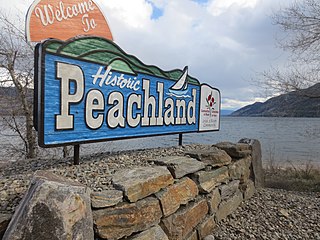
Peachland is a district municipality in the Okanagan Valley on the west side of Okanagan Lake in British Columbia, Canada. It was founded in 1899 by John Moore Robinson, although the region had long been home to the Okanagan people. Peachland is approximately half-an-hour's drive south of the city of Kelowna and about a 20-minute drive north of Summerland. The Okanagan Valley is very narrow in the area and there are few terraces that mark former lake levels and the former lake bottom. As a result, the city is largely located on a steep sidehill. Like many other areas in the Okanagan, Peachland is rapidly growing, with new residents coming from all across Canada. Across the lake from Peachland is Rattlesnake Island, home of the legendary Ogopogo. Peachland is approximately 370 km from Vancouver, British Columbia, on the British Columbia south coast.

On August 16, 2003, at about 4 a.m. local time, a wildfire started via lightning strike near Rattlesnake Island in Okanagan Mountain Provincial Park, British Columbia, Canada. The wildfire was fuelled by a constant wind and the driest summer on record up to that time. Within a few days it grew into a firestorm.

Okanagan Mountain Provincial Park is a provincial park within the Okanagan-Similkameen Regional District of British Columbia, Canada, focused on the mountain of the same name and located on the east side of Okanagan Lake, opposite Peachland and immediately south of the City of Kelowna. The park is one of the largest in the area, covering 110.38 square kilometres (42.62 sq mi). Most of the park is only accessible by foot, horseback, bicycle, or boat as motor vehicle access is restricted to BC Parks staff and technicians servicing the three telecommunications towers in the park.
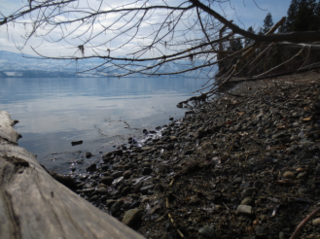
Lakeview Heights is a community within the City of West Kelowna, British Columbia, Canada. Lakeview Heights is on the west side of Okanagan Lake, across the lake from Kelowna. Lakeview Heights is east of Mount Boucherie and south of Tsinstikeptum Indian Reserve No. 10.
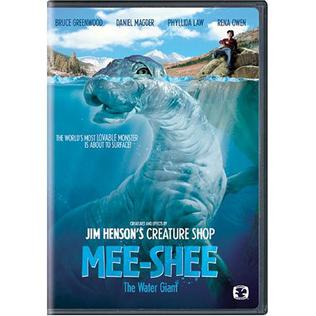
Mee-Shee: The Water Giant is a British-German family film shot in New Zealand in 2002 and released in 2005. It stars Bruce Greenwood, Rena Owen, Tom Jackson and Daniel Magder.
Grand Chief Stewart Phillip is an Okanagan Aboriginal leader who has served as president of the Union of British Columbia Indian Chiefs since 1998. As chief of the Penticton Indian Band in British Columbia from 1994 until 2008, as well as chair of the Okanagan Nation Alliance, he has advocated for Aboriginal rights for the First Nations in that province and particularly in the Okanagan region. He was awarded the title Grand Chief by the Okanagan Nation in 2006 in honour of his lifetime of commitment to and work for Indigenous rights and title.

Vaseux Lake is a shallow freshwater lake located along the course of the Okanagan River in the Okanagan Valley of British Columbia, Canada.

West Kelowna, formerly known as Westside and colloquially known as Westbank, is a city in British Columbia's Okanagan Valley on the west shore of Okanagan Lake. The city encompasses several neighbourhoods, including Casa Loma, Gellatly, Glenrosa, Lakeview Heights, Shannon Lake, Smith Creek, Rose Valley, Westbank, and West Kelowna Estates. As of 2021, West Kelowna had an estimated population of 36,078.

In Canadian folklore, the Igopogo is a mythical creature said to dwell in Lake Simcoe, Ontario. The creature's name is ostensibly based on the Ogopogo, of Lake Okanagan, British Columbia, and also the title of the 1952 book I Go Pogo, a slogan often mentioned in the comic. Other nicknames for the Igopogo include Beaverton Bessie, after Beaverton, Ontario, and "Kempenfelt Kelly" after the bay that extends from the lake into the city of Barrie, Ontario. The city of Barrie erected The Sea Serpent sculpture, representing the legendary Igopogo, at the waterfront.

Chester Peter "Chess" Lyons was a Canadian outdoorsman and natural historian. The author of several books on the flora and landscape of the Pacific Northwest, Lyons is best known for his popular and widely cited botanical field guides.

Susan Louisa Moir Allison was a Canadian author and pioneer. In 2010 Allison was designated a National Historic Person by the Canadian Government.

White Lake Grasslands Protected Area is a conservation site located in the Regional District of Okanagan-Similkameen of British Columbia, Canada. It was established on April 18, 2001 by an order-in-council under the Environment and Land Use Act to protect the semi-arid grassland and pine forest ecosystem west of Vaseux Lake.
